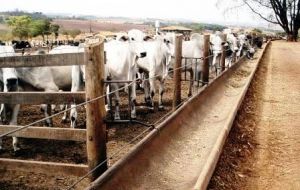MercoPress. South Atlantic News Agency
Brazil feed lot industry more cautious about expansion
 In 2008, Brazilian feed lots managed 1.6 million cattle.
In 2008, Brazilian feed lots managed 1.6 million cattle. Brazil is planning to increase the number of cattle in feed lots by 4.6% which would be equivalent to a total of 1.673.500 heads, according to Beef Point, a Brazilian portal linked to the meat industry.
The number is the result of a survey among the top 50 Brazilian companies involved in feed lots and which last year fattened 1.599.465 cattle, which represented a leap of 27% over 2007 but below the 34.5% of 2006.
The survey showed some companies are not planning to increase the number of cattle in feed lots while others are thinking in reducing them.
Goias in central Brazil is the state which leads in feed lots, followed by Sao Paulo, Matto Grosso, Minas Gerais and Parana. Most of the production of feed lots is delivered to abattoirs between August and December.
The crisis suffered by the Brazilian meat packing industry, as a direct consequence of the world recession has triggered big changes and consolidation in the industry, while livestock companies and ranchers are looking for ways to cut risks when the moment of sale comes.
Feed lots became quite popular in 2004 when the boom of beef exports, (Brazil is the world’s leading meat exporter), and livestock prices begun increasing. Something similar happened in neighbouring Argentina and Brazil, but costs have become tighter and so have profit margins.
In related news Chile has again opened its borders to Brazilian beef. The announcement was done by Brazilian Agriculture Defence Secretary Inacio Kroetz and Brazilian Beef Exporters Association Otavio Cancado following a visit to Chile.
In 2007 because of the foot and mouth disease outbreaks in Brazil, Chile banned beef imports. Brazil since 2004 had become Chile’s main supplier of beef totalling 220 million US dollars annually, equivalent to almost 80% of the market




Top Comments
Disclaimer & comment rulesCommenting for this story is now closed.
If you have a Facebook account, become a fan and comment on our Facebook Page!